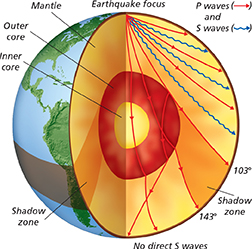Seismographic Data
A worldwide network of seismographs has provided scientists with a wealth of data on earthquakes. These data have enabled geologists to map the distribution of earthquakes. In addition, seismographic data have been used to probe the structure of Earth's interior. Unfortunately, so far these data have not resulted in a method that can be used to predict when earthquakes will occur.
Every day, earthquakes occur all around the world.  Most earthquakes are concentrated along plate boundaries, where many faults are found. Some earthquakes occur in the interior of plates, far away from plate boundaries. As a plate moves, it undergoes deformation. The resulting stresses are released as earthquakes.
Most earthquakes are concentrated along plate boundaries, where many faults are found. Some earthquakes occur in the interior of plates, far away from plate boundaries. As a plate moves, it undergoes deformation. The resulting stresses are released as earthquakes.
Scientists have mapped Earth's interior, analyzing how seismic waves move through its layers. The speeds of seismic waves and the paths they take are affected by the temperature, composition, and density of the rocks they pass through. Seismic waves are much like other kinds of waves. When they interact with boundaries between different kinds of rock within Earth, they can be reflected, refracted, or diffracted. Look at Figure 37. Geologists infer that Earth's outer core is liquid because S waves cannot pass through it. They can also tell that the core is mostly iron because P waves travel through it at a speed that matches laboratory experiments on iron.
Figure 37 Earth's liquid outer core blocks S waves and bends P waves. The result is a shadow zone on the surface where no direct seismic waves from an earthquake are detected. Comparing and Contrasting Compare where P waves and S waves can be detected on Earth's surface. What does this reveal about Earth's layers?
 dd
ddSection 22.5 Assessment
Reviewing Concepts
 Describe how faults and folds form in Earth's crust.
Describe how faults and folds form in Earth's crust. What happens along a fault before and during an earthquake?
What happens along a fault before and during an earthquake? How can the magnitude and location of earthquakes be measured?
How can the magnitude and location of earthquakes be measured? Where do earthquakes occur most often?
Where do earthquakes occur most often?
Critical Thinking
Comparing and Contrasting Compare and contrast P waves, S waves, and surface waves.
Relating Cause and Effect How can layers within Earth be identified by means of seismic waves?
Math Practice
How much more energy is released by a Mw 8 earthquake than a Mw 6 earthquake?
P waves move through the crust at a speed of about 6.5 km/s. How far will a P wave move in 5 seconds?




